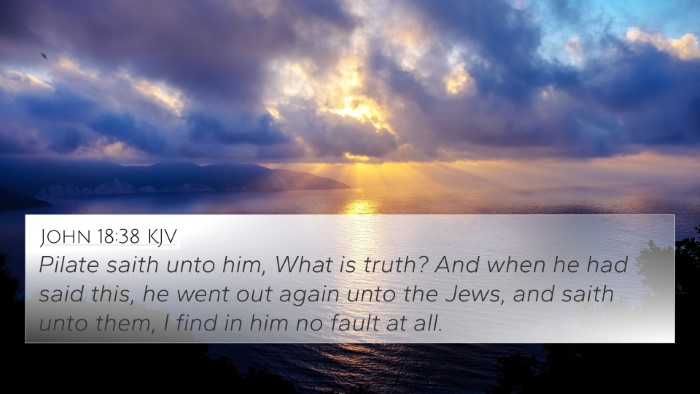Summary and Interpretation
The verse presents a crucial moment during the trial of Jesus before Pilate, where the Roman governor declares Jesus innocent. This statement holds significant theological and narrative weight within the Gospel of Luke and the larger context of the New Testament.
Contextual Background
Leading up to this verse, Jesus has been arrested, tried, and brought before Pilate, who is tasked with determining His fate. The Jewish leaders accuse Jesus of various crimes, but Pilate's declaration, “I find no fault in this man,” underscores the innocence of Jesus in the face of false charges.
Thematic Insights
- Innocence of Christ: Pilate's proclamation not only reinforces Jesus' innocence but serves as divine confirmation of His sinless nature, connecting to numerous prophecies about the Messiah.
- Authority and Accountability: This interaction exemplifies the authority of Roman governance juxtaposed with the fulfillment of divine prophecy.
- Public Sentiment: Pilate’s address to both the chief priests and the people highlights the tension between political authority and popular opinion.
- Divine Purpose: The verse emphasizes the sovereignty of God in orchestrating redemption through the unjust suffering of His Son.
Cross-References to Luke 23:4
This verse connects with various scriptures that contribute to a deeper understanding of its meaning and context:
- John 18:38: Pilate's earlier question to Jesus, "What is truth?" reveals the ambiguity and challenges present in Roman governance.
- Matthew 27:24: Pilate's act of washing his hands signifies his attempts to absolve himself from the consequences of condemning an innocent man.
- Luke 23:15: This verse reiterates Pilate’s findings, saying, “No, nor yet Herod: for I sent you to him; and lo, nothing worthy of death is done unto him.”
- Isaiah 53:7: A prophecy about the suffering servant, emphasizing the silence of Jesus before His accusers.
- 1 Peter 2:22: “Who did no sin, neither was guile found in his mouth,” affirming the New Testament portrayal of Jesus' innocence.
- Acts 3:14: Peter alludes to Jesus as the “Holy One and the Just,” reinforcing Pilate’s assessment of innocence.
- Hebrews 4:15: Portrays Jesus as a high priest who is “without sin,” linking His nature to the themes presented in Luke 23:4.
- Philippians 2:7-8: Illustrates Jesus taking on the form of a servant and being obedient unto death, connecting to His innocent suffering.
- Revelation 5:6: The Lamb, having been slain, emphasizes the perfection and innocence of Christ that culminates in redemption.
- Romans 5:8: God’s demonstration of love through Christ underscores the significance of Jesus’ innocence for our salvation.
Key Themes from Public Domain Commentaries
Insights from Matthew Henry, Albert Barnes, and Adam Clarke shed further light on this verse:
Matthew Henry
Henry emphasizes that Pilate's declaration of Jesus’ innocence serves as a poignant illustration of the unjust treatment of Christ. He notes that this moment foreshadows the ultimate injustice—the crucifixion of the sinless Son of God. This aligns with the overarching theme of divine justice prevailing amidst human injustice.
Albert Barnes
Barnes discusses the implications of Pilate's declaration, highlighting that it reflects not only the innocence of Christ but also the political maneuvering of the Jewish leaders. He emphasizes that Pilate's statement is an acknowledgment of the injustice perpetrated against Jesus, showcasing a critical intersection of faith and governance.
Adam Clarke
Clarke notes that Pilate's recognition of Jesus' innocence is particularly significant and points to the prophetic nature of Jesus’ mission. He argues that this verdict from a Roman governor further validates Jesus as the prophesied Messiah and highlights the divine plan for redemption that transcends earthly judgments.
Further Exploration of Thematic Connections
Readers are encouraged to engage in a cross-reference Bible study to explore the relationships between various scriptures. By using a Bible concordance or Bible cross-reference guide, one can uncover interconnected themes that enrich the understanding of biblical texts.
Tools for Bible Cross-Referencing
- Bible Concordances: Useful for locating verses and themes.
- Bible Study Software: Helps in systematic verse analysis.
- Online Bible Libraries: Provide access to commentaries and cross-referenced materials.
- Study Groups: Engage in discussion of related verses to enhance comprehension.
Conclusion
Luke 23:4 acts as a powerful affirmation of Jesus' innocence and ignites essential conversations about justice, authority, and fulfillment of prophecy in the biblical narrative. By examining this verse through cross-references and combining insights from esteemed commentaries, we gain a more profound understanding of its significance within the gospel context.













